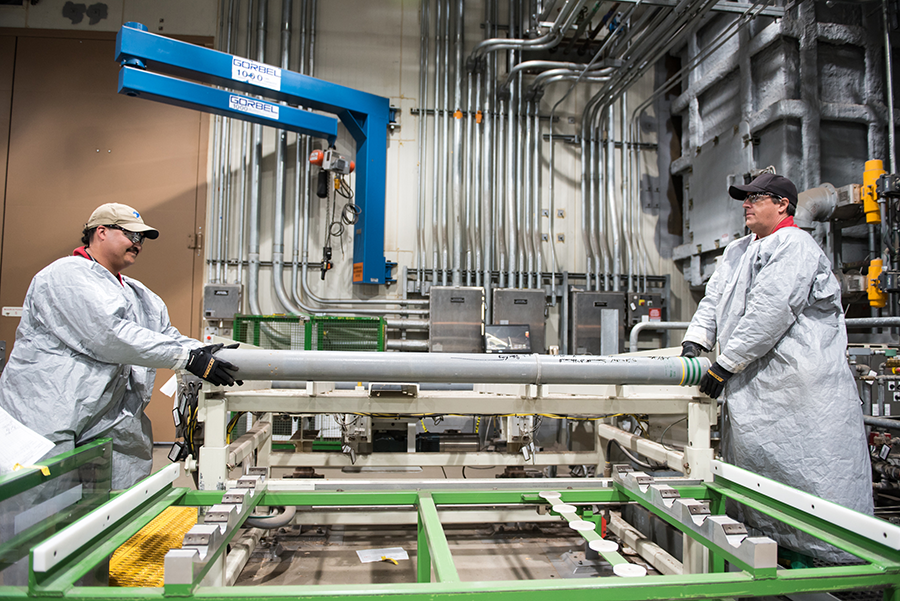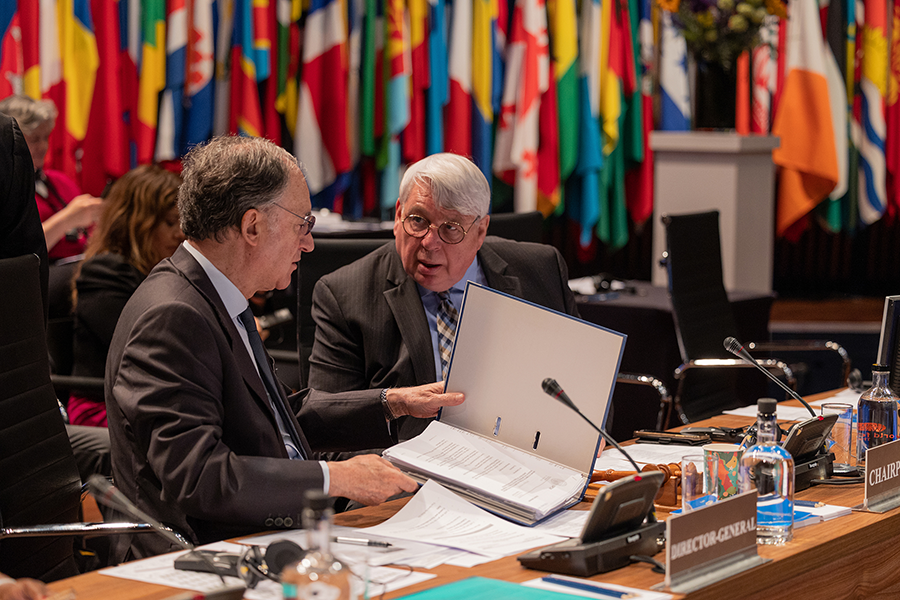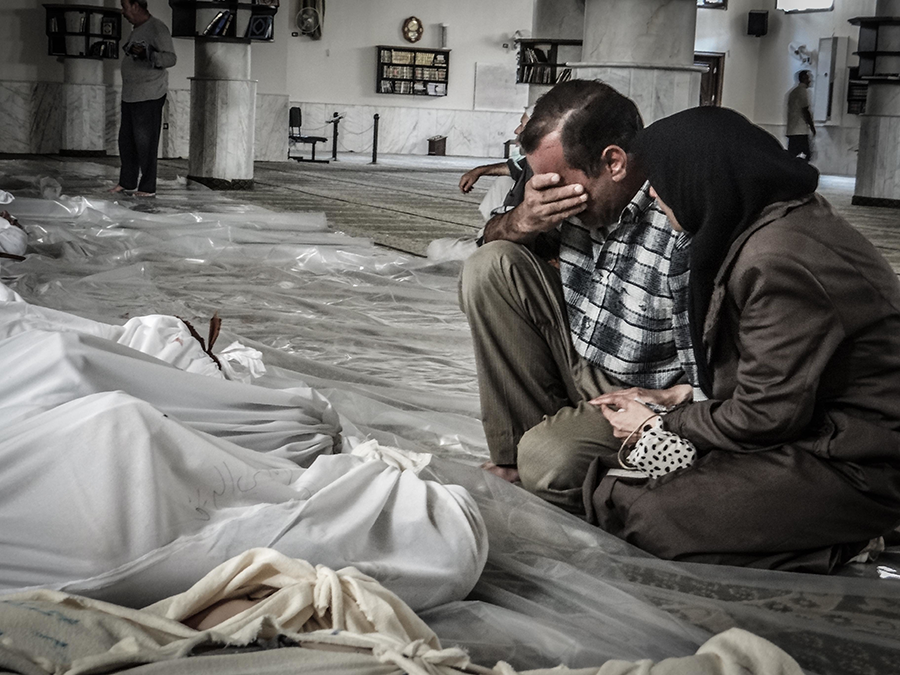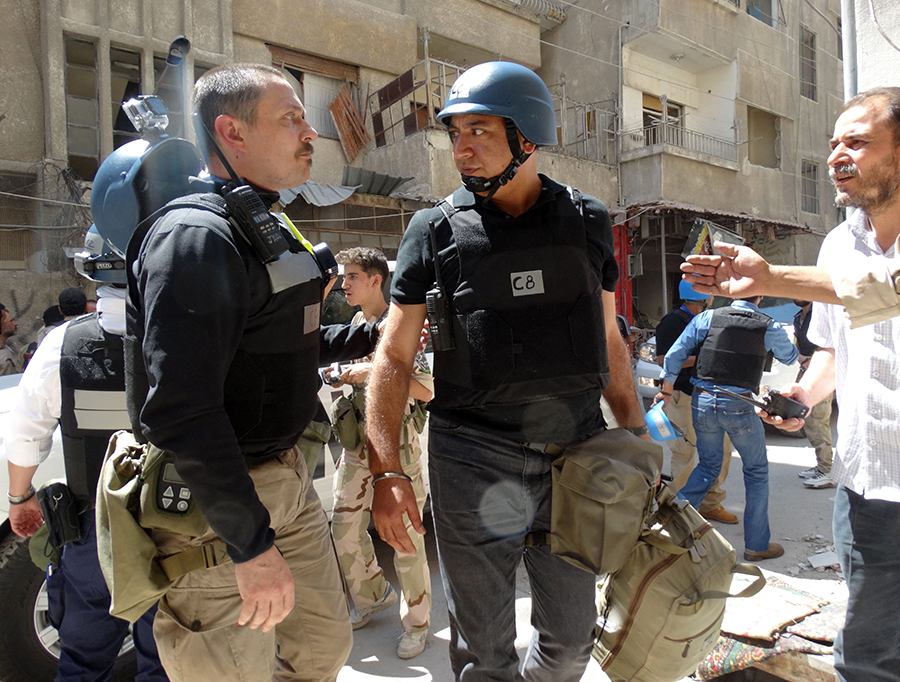"In my home there are few publications that we actually get hard copies of, but [Arms Control Today] is one and it's the only one my husband and I fight over who gets to read it first."
The Chemical Weapons Convention Is Stronger Than You Think
October 2023
By Stefano Costanzi
On July 7, the United States announced that it had destroyed the last of its massive stockpile of chemical weapons.
 Yet, the milestone extends far beyond this one country. It also marks the elimination of all of the world’s publicly declared chemical weapons. As reported by the Organisation for the Prohibition of Chemical Weapons (OPCW), which oversees implementation of the Chemical Weapons Convention (CWC), all 72,304 metric tons of declared chemical weapons stockpiles that CWC states-parties had accumulated before they ratified or acceded to the convention have now been destroyed.1
Yet, the milestone extends far beyond this one country. It also marks the elimination of all of the world’s publicly declared chemical weapons. As reported by the Organisation for the Prohibition of Chemical Weapons (OPCW), which oversees implementation of the Chemical Weapons Convention (CWC), all 72,304 metric tons of declared chemical weapons stockpiles that CWC states-parties had accumulated before they ratified or acceded to the convention have now been destroyed.1
This remarkable achievement is testimony to the success of the CWC, an international treaty that imposes a complete ban on chemical weapons. Before the CWC entered into force in 1997, the main arms control treaty on chemical weapons was the 1925 Geneva Protocol, which banned the use of these weapons but not their development and stockpiling. Most countries interpreted the protocol as a “no first use” ban, meaning they could reserve the right to use chemical weapons in retaliation for a chemical weapons attack. As a result, chemical weapons were still produced and stockpiled. When the CWC took effect, things changed drastically because the treaty clearly mandated states-parties to declare and verifiably destroy their chemical weapons arsenals.
Even so, the chemical weapons threat has not been eradicated completely. A few countries did not sign the treaty, and some that did, such as Syria, appear to have retained undeclared stocks. This contributed to a tense atmosphere as states-parties held the fifth CWC review conference at The Hague in May.2 In addition to a troubled geopolitical situation, predominantly due to the war in Ukraine, states-parties have had to grapple with the fact that the treaty has been violated many times in recent years.3
In the Syrian civil war, chemical weapons were used more than 300 times between 2012 and 2019. Most of these attacks were attributed to the Syrian government and the rest to the Islamic State group. In February 2017, Kim Jong Nam, half-brother of North Korean leader Kim Jong Un, was assassinated in Malaysia with the nerve agent VX. In March 2018, Sergei Skripal, a former Russian intelligence officer, and his daughter, Yulia, were the targets of an assassination attempt in the United Kingdom. The attack was carried out using a nerve agent of the Novichok class, a group of highly toxic chemicals developed in the Soviet Union during the Cold War.4 Three months later, Dawn Sturgess, a woman who lived not far from the Skripals, died after serendipitously coming into contact with a discarded perfume bottle filled with the same Novichok agent, which had been found in a dumpster by her boyfriend. Following investigations, prosecutors from the British Counter Terrorism Division authorized charges against three members of the GRU, the Russian military intelligence service.5 In August 2020, Russian opposition leader Alexei Navalny was the target of another assassination attempt in Russia, with a different Novichok agent. Unsurprisingly, these incidents are regarded in strikingly different ways by different states, amid accusations, denials, and disinformation campaigns.
Despite the fact that the world is not yet completely free of chemical weapons and notwithstanding the tension that characterized the last review conference, the CWC undoubtedly is a very strong treaty that has significantly reduced the threat posed by this horrific category of weapons. Some work is still needed to keep the treaty and the organization that governs it current. This process risks being slowed down by the geopolitical situation, but a planning document produced by the OPCW Technical Secretariat indicates that constructive steps are being taken.6
A Strong Treaty
Fundamentally, the strength of the CWC as a robust disarmament and nonproliferation treaty rests on several pillars.7 Chemical weapons exploit the toxicity of chemicals to intentionally cause harm or death to humans or animals.8 The CWC is a comprehensive international treaty that poses a complete ban on chemical weapons, prohibiting not only the use of these weapons but also their development, acquisition, stockpiling, retention, and transfer. The CWC also prohibits military preparations to use chemical weapons, as well as the provision of assistance or encouragement to anyone to engage in activities prohibited by the convention.
One of the convention’s pillars is qualitative universality: the treaty is of unlimited duration and designed to be flexible enough to maintain its relevance in spite of changing circumstances. Above all, this is achieved through the so-called general purpose criterion under Article II, which establishes that any toxic chemical, unless intended for purposes not prohibited by the convention, is to be regarded as a chemical weapon. That means that the CWC prohibits all chemical weapons, present and future, including those that were unknown when the treaty was negotiated. Whenever a toxic chemical is developed into a chemical weapon, that weapon is automatically subject to the comprehensive ban posed by the treaty. In this sense, the CWC is similar to the Biological Weapons Convention (BWC), which poses an analogous comprehensive and general ban on biological weapons.
 Another pillar is the convention’s quantitative universality: with 193 states-parties, the CWC enjoys near universal adherence. Israel has signed the convention, but has not ratified it. Egypt, North Korea, and South Sudan have not signed the treaty. According to the OPCW, “98 percent of the world’s population lives under the protection” of the CWC.9
Another pillar is the convention’s quantitative universality: with 193 states-parties, the CWC enjoys near universal adherence. Israel has signed the convention, but has not ratified it. Egypt, North Korea, and South Sudan have not signed the treaty. According to the OPCW, “98 percent of the world’s population lives under the protection” of the CWC.9
The convention’s third pillar is its verification regime, which the BWC lacks. Chemical weapons destruction programs, as well as industrial activities, are subjected to a scrupulous process of declarations and verification.10 States-parties are required to submit annual declarations of yet-to-be destroyed stockpiles, production facilities, and activities that are not prohibited by the convention but involve chemicals that could pose a risk. Some of these declarations trigger on-site inspections by the OPCW Inspectorate. The verification regime is supported by three schedules of toxic chemicals and precursors for their synthesis that have been recognized as posing a chemical weapons threat.11
The Syrian Civil War
As paradoxical as it may seem, the Syrian civil war is perhaps the most evident example of the success of the CWC. The largest chemical weapons attack that occurred after the convention entered into force was in Ghouta on August 21, 2013. Surface-to-surface rockets hit this suburb of Damascus, releasing the deadly nerve agent sarin and causing the deaths of at least 1,200 people and perhaps more than 1,400, according to some sources. Many were civilians.12
Following these events, diplomatic initiatives led by Russia and the United States resulted in a framework for the destruction of Syria’s chemical weapons stockpiles. Syria then requested to accede to the CWC, and inspections of the Syrian declared stockpiles—more than 1,300 metric tons of chemical warfare agents and precursors—began in October 2013. Finally, through an international effort spearheaded by the United States, the destruction of declared Syrian chemical weapons stockpiles was completed in January 2016.13
This did not end the use of chemical weapons in the Syrian war. The Global Public Policy Institute, an independent think tank based in Berlin, counted a total of 349 confirmed chemical weapons incidents between 2012 and 2019, most of which occurred after Syria acceded to the CWC. According to the institute, almost all of these attacks are attributable to the Syrian government, while a handful is attributable to the Islamic State group.14 At first glance, this may seem like a treaty failure, but a closer look at the data reveals that the deaths caused by chemical weapons attacks decreased significantly after Syria joined the CWC.
 According to the institute’s data, 1,444 people were killed in 38 chemical weapons attacks in Syria between December 2012 and October 2013, prior to the country’s CWC accession. The great majority of these deaths occurred in the 2013 Ghouta attack. Although many chemical attacks occurred after Syria became a CWC state-party, these attacks were significantly smaller in caliber, causing a total of 517 deaths in 311 attacks. This suggests that the OPCW-verified destruction of Syria’s declared chemical weapons arsenal had a profoundly positive impact on reducing the number of chemical weapons deaths.
According to the institute’s data, 1,444 people were killed in 38 chemical weapons attacks in Syria between December 2012 and October 2013, prior to the country’s CWC accession. The great majority of these deaths occurred in the 2013 Ghouta attack. Although many chemical attacks occurred after Syria became a CWC state-party, these attacks were significantly smaller in caliber, causing a total of 517 deaths in 311 attacks. This suggests that the OPCW-verified destruction of Syria’s declared chemical weapons arsenal had a profoundly positive impact on reducing the number of chemical weapons deaths.
Notably, the majority of the chemical weapons attacks after 2013 were perpetrated with chlorine, a toxic chemical that has vast legitimate applications, including for water sanitization. Its use as a weapon is indeed a flagrant violation of the CWC mandates, but due to chlorine’s legitimate uses, Syria was not restricted from accessing this material after joining the CWC. This explains its availability for use as a weapon throughout the war.
Nonetheless, unresolved and less than clear issues in Syria remain a cause of great concern. The OPCW has three active missions dedicated to investigating Syria’s compliance with the CWC: the Declaration and Assessment Team, which is working with the Syrian government to address issues that have been identified in the initial CWC declaration; the Fact Finding Mission, which is investigating alleged chemical weapons incidents in Syria and assessing whether they have actually occurred; and the Investigation and Identification Team (IIT), which is identifying the perpetrators of specific chemical weapons incidents in Syria.15
The IIT, which was established in 2018, has generated considerable controversy, with Syria and a minority of other states-parties, including Russia, claiming that its creation has overreached the OPCW mandate. In 2021, the CWC conference of states-parties suspended certain rights and privileges of Syria under the convention. These rights and privileges will be reinstated only after Syria satisfactorily complies with all measures requested by the conference. A minority of states-parties has asserted that Syria is in full compliance with the CWC mandates.
The Fifth Review Conference
The fifth CWC review conference, which took place May 15 to 19 in The Hague, provided an opportunity to highlight the successes of the convention in the last five years, and they were well summarized by the Canadian delegation’s statement.16 In addition to the fact that the destruction of the stockpile of chemical weapons under the CWC was about to be completed, these achievements include the construction of the OPCW Chemistry and Technology Center, a state-of-the-art facility that will help the OPCW keep up with chemistry developments and address emerging threats; the identification of perpetrators of several chemical weapons attacks; and the first amendment of the CWC schedules, or lists of treaty-regulated chemicals, since the convention’s entrance into force, with the addition of highly toxic Novichok and carbamate agents in 2019. In addition, in 2021 the conference of states-parties adopted a decision that clarifies that it is incompatible under the treaty to use aerosolized chemicals that act on the central nervous system, such as opioids, for law enforcement purposes.
Some of the more substantive issues raised at the review conference were covered by statements produced by representatives of nongovernmental organizations, academic institutions, think tanks, and advocacy groups.17 Importantly, the conference dedicated an entire hour to joint statements on topics coordinated by the CWC Coalition, an umbrella organization of civil society organizations.18 These issues included the need to maintain a world free of chemical weapons after completion of the destruction of the stockpiles declared by states-parties; strengthen the prohibition on the use of chemical weapons; prevent the acquisition of chemical weapons by nonstate actors, including terrorists and criminal organizations; promote full national implementation of the CWC mandates by all states-parties; and address problems caused by old chemical weapons that were discarded by dumping them at sea.
Reviewing the CWC Schedules
One of the joint statements coordinated by the CWC Coalition covered the need to realign the CWC schedules with the 21st century chemical weapons landscape.19 Under the treaty, any toxic chemical is considered a chemical weapon unless it is intended for a purpose that is not prohibited by the convention. Nevertheless, chemicals listed on the CWC schedules have a special status because they are subject unequivocally to declaration requirements and are the primary focus of OPCW inspectors and OPCW designated laboratories. The problem is that the CWC schedules, crafted when the convention was negotiated, are focused on toxic chemicals and precursors that had been relevant for 20th century chemical warfare. Although some chemicals were added to the schedules in 2019, action is needed to realign these lists with the current threat.
One problem area is the existence of chemical weapons agents and precursors for their synthesis that are currently unscheduled, including some Novichok agents and precursors for the synthesis of Novichoks and carbamates.20 Toxic chemicals that act on the central nervous system are another area of concern. Although many of these chemicals, such as opioids, are highly toxic, only a single central nervous system-acting chemical is currently listed on the CWC schedules: the hallucinogenic chemical BZ.
Biological toxins and bioregulators are also a concern.21 Biological toxins are toxic chemicals produced by living organisms, such as microorganisms, animals, or plants. Bioregulators are chemicals produced by the human body that have an effect on its functioning, for instance by affecting neurotransmission. Biological toxins are only minimally covered by the CWC schedules, while bioregulators are not covered at all.
 The joint statement noted that the CWC schedules could be strengthened by improving the balance between the individual chemicals and families of chemicals that are listed, as well as revisiting the scope of some families of chemicals. Some entries in the CWC schedules identify families of related chemicals rather than individual chemicals. This approach contributes to the strength of the schedules, setting them apart from lists of chemicals exclusively based on the enumeration of individual chemicals. Listing families of related chemicals makes the CWC schedules more proactive and resilient to the passage of time, bringing under their coverage not only currently known chemicals but also related ones that could be developed in the future. The CWC schedules could be strengthened by replacing with families of chemicals some of the entries that currently identify single chemicals.22
The joint statement noted that the CWC schedules could be strengthened by improving the balance between the individual chemicals and families of chemicals that are listed, as well as revisiting the scope of some families of chemicals. Some entries in the CWC schedules identify families of related chemicals rather than individual chemicals. This approach contributes to the strength of the schedules, setting them apart from lists of chemicals exclusively based on the enumeration of individual chemicals. Listing families of related chemicals makes the CWC schedules more proactive and resilient to the passage of time, bringing under their coverage not only currently known chemicals but also related ones that could be developed in the future. The CWC schedules could be strengthened by replacing with families of chemicals some of the entries that currently identify single chemicals.22
At the same time, the CWC schedules could be streamlined by reducing the size of some of the listed families of chemicals that currently extend beyond chemicals that trigger chemical weapons concern. Such unnecessarily large families pose an avoidable burden on inspectors, laboratories that are tasked with conducting forensics analysis, export control officers, customs officials, and the chemical industry.
Circumscribing the scope of some families of chemicals is in line with a proposal presented by the U.S. delegation at a side event on the margins of the review conference. The proposal aims to streamline the verification regime for the largest family of chemicals in the CWC schedules. This would allow resources currently devoted to inspecting plants that work with chemicals that are recognized as not posing a threat to the mission of the CWC to be redirected toward more relevant issues. For example, resources spent to inspect textile industry plants that work with organophosphorus flame retardants that do not appear to have a role as precursors for the synthesis of nerve agents could be redirected to other, more pressing tasks.
Looking Ahead
As the review conference ended, there was no consensus on a final document to establish OPCW priorities for the next five years. Given the unstable geopolitical context, this was hardly a surprise. The fourth review conference, in 2018, also failed to reach consensus on a final document. The last review conference to produce a consensus document was the one held in 2013.23 All states-parties expressed regret at this year’s outcome. Russia blamed the stalemate on a lack of flexibility from some states-parties. The United States blamed states that still use chemical weapons.
Many participants, including the conference chair, Henk Cor van der Kwast of the Netherlands, attributed this outcome to the lack of time. Two weeks were allotted for previous review conferences, but only five days were given to this year’s meeting. Nevertheless, delegates praised the work Lauri Kuusing of Estonia, who chaired the working group responsible for preparing the conference, and José Antonio Zabalgoitia of Mexico, who chaired the committee of the whole, which provided the main forum for state-party efforts to reach consensus on a final document.
Although a final document proved elusive, it was clear from the closing statements of most national delegations that there was indeed consensus on most of the draft document. Despite the divergences, many states-parties expressed hope that the OPCW Executive Council and the conference of states-parties could follow up on issues on which there appears to be general agreement. They include strengthening the verification regime, which is fundamental to supporting chemical weapons disarmament and nonproliferation; increasing geographical representation within the OPCW; expanding the dialogue between states-parties and civil society; and expanding capacity building and international cooperation efforts.
It is encouraging that all these issues are addressed in the medium-term plan of the OPCW for the years 2024 to 2028 as prepared by the Technical Secretariat for the October 2023 meeting of the Executive Council. Even in the absence of a review conference consensus document, it is likely that the work that was done in preparation for the conference and during the conference itself can be leveraged and actualized by the states-parties during the next five years. The CWC mission has progressed significantly in the last five years, and that needs to continue.
ENDNOTES
1. Organisation for the Prohibition of Chemical Weapons (OPCW), “OPCW by the Numbers,” n.d., https://www.opcw.org/media-centre/opcw-numbers (accessed September 25, 2023).
2. OPCW, “RC-5: Fifth Review Conference,” n.d., https://www.opcw.org/calendar/rc (accessed September 25, 2023).
3. Rebecca Hersman and William Pittinos, “Restoring Restraint: Enforcing Accountability for Users of Chemical Weapons,” Center for Strategic and International Studies, 2018, https://www.csis.org/analysis/restoring-restraint; Stefano Costanzi and Gregory D. Koblentz, “Updating the CWC: How We Got Here and What Is Next,” Arms Control Today, April 2020; Stefano Costanzi and Gregory D. Koblentz, “Strengthening Controls on Novichoks: A Family-Based Approach to Covering A-Series Sgents and Precursors Under the Chemical-Weapons Nonproliferation Regime,” The Nonproliferation Review, Vol. 28, Nos. 1-3 (2021): 95-113.
4. Marcin Kloske and Zygfryd Witkiewicz, “Novichoks: The A-Group of Organophosphorus Chemical Warfare Agents,” Chemosphere, Vol. 221 (2019), pp. 672-682.
5. UK Counter Terrorism Policing, “Salisbury & Amesbury Investigation,” September 21, 2021, https://www.counterterrorism.police.uk/salisbury/.
6. OPCW Executive Council, “Note by the Technical Secretariat: Medium-Term Plan of the Organisation for the Prohibition of Chemical Weapons 2024-2028,” EC-104/S/1, C-28/S/1, August 14, 2023, https://www.opcw.org/sites/default/files/documents/2023/08/c28s01%20ec104s01%2B%28e%29_0.pdf.
7. Jean Pascal Zanders, “The Chemical Weapons Convention and Universality: A Question of Quality Over Quantity?” Disarmament Forum, Vol. 4 (December 2002), pp. 23-31.
8. Stefano Costanzi, “Chemical Warfare Agents,” Kirk-Othmer Encyclopedia of Chemical Technology, 2020, pp. 1-32.
9. OPCW, “Achieving Universality: Ensuring a Truly Global Treaty,” n.d., https://www.opcw.org/our-work/achieving-universality-convention (accessed September 25, 2023).
10. Ron G. Manley, “Verification Under the Chemical Weapons Convention: A Reflective Review,” Pure and Applied Chemistry, Vol. 74, No. 12 (2002): 2235-2240; OPCW, “Eliminating Chemical Weapons: Committed to Complete and Verifiable Destruction,” n.d., https://www.opcw.org/our-work/eliminating-chemical-weapons (accessed September 25, 2023).
11. Stefano Costanzi et al., “Lists of Chemical Warfare Agents and Precursors From International Nonproliferation Frameworks: Structural Annotation and Chemical Fingerprint Analysis,” Journal of Chemical Information and Modeling, Vol. 60, No. 10 (2020): 4804-4816.
12. Tobias Schneider and Theresa Lütkefend, “Nowhere to Hide: The Logic of Chemical Weapons Use in Syria,” Global Public Policy Institute (GPPI), February 2019, https://www.gppi.net/2019/02/17/the-logic-of-chemical-weapons-use-in-syria.
13. Organisation for the Prohibition of Chemical Weapons - UN Joint Mission, “Background,” n.d., https://opcw.unmissions.org/background (accessed September 25, 2023); Paul F. Walker, “Syrian Chemical Weapons Destruction: Taking Stock and Looking Ahead,” Arms Control Today, December 2014; Arms Control Association, “Timeline of Syrian Chemical Weapons Activity, 2012-2022,” February 2022, https://www.armscontrol.org/factsheets/Timeline-of-Syrian-Chemical-Weapons-Activity.
14. GPPI, “The Specter of Chemical Weapons Use in Syria,” n.d., https://chemicalweapons.gppi.net/ (accessed September 25, 2023).
15. OPCW, “Syria and the OPCW,” n.d., https://www.opcw.org/media-centre/featured-topics/opcw-and-syria (accessed September 25, 2023).
16. “Statement of Canada to the Fifth Review Conference of the Chemical Weapons Convention,” n.d., https://www.opcw.org/sites/default/files/documents/2023/05/Canada%20-%20CWC%20RC5%20National%20Statement.pdf.
17. For nongovernmental organization statements to the fifth Chemical Weapons Convention review conference, see OPCW, “Fifth Review Conference,” n.d., https://www.opcw.org/resources/documents/conference-states-parties/fifth-review-conference#NGO (accessed September 25, 2023).
18. CWC Coalition, “NGO Joint Statements,” n.d., https://www.cwccoalition.org/revcon5-ngo-statements/ (accessed September 25, 2023).
19. Stefano Costanzi, Michael Crowley, and Malcolm Dando, “NGO Joint Statement; The CWC Schedules: Addressing Scientific and Technological Advances in the Fourth Industrial Revolution,” n.d., https://www.opcw.org/sites/default/files/documents/2023/05/Joint%20NGO%20Statement%20-%20Statement%20on%20CWC%20Schedules%20.pdf.
20. Costanzi and Koblentz, “Strengthening Controls on Novichoks.”
21. Michael Crowley and Malcolm R. Dando, Toxin and Bioregulator Weapons: Preventing the Misuse of the Chemical and Life Sciences (Cham, Switzerland: Palgrave Macmillan, 2022).
22. Costanzi and Koblentz, “Strengthening Controls on Novichoks.”
23. OPCW, “Third Review Conference Concludes With Consensus Final Document and Political Declaration,” April 19, 2013, https://www.opcw.org/media-centre/news/2013/04/third-review-conference-concludes-consensus-final-document-and-political.
Stefano Costanzi, a professor of chemistry at American University, directs the university’s chemistry graduate programs and the Science and Policy Undergraduate Certificate.
